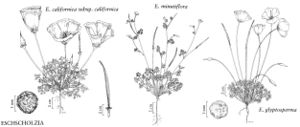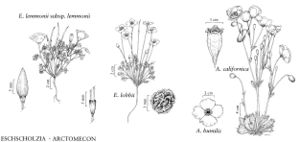Eschscholzia
in C. G. D. Nees, Horae Phys. Berol., 73. 1820.
Herbs, annual or perennial, scapose or caulescent, from taproots; sap colorless or clear orange. Stems leafy. Leaves alternate, basal and sometimes cauline, petiolate; blade 1-4× pinnately deeply lobed, lobes of each order usually 3; ultimate lobes narrow. Inflorescences terminal, cymose with bracts present, or 1-flowered. Flowers: receptacle dilated, forming cup beneath calyx, sometimes with free rim; perianth and androecium perigynous; sepals 2, connate, calyptrate, deciduous as unit; petals 4, rarely more (doubled flowers), obovate to obcuneate, with satin sheen from microscopic linear grooves; stamens 12-many; pistil 2-carpellate; ovary 1-locular; style absent; stigmas 4-8, spreading, linear. Fruits capsular, cylindric, 2-valved, dehiscing from base along placentas, often explosively. Seeds many, tan, brown, or black, spheric to ovoid, reticulate, ridged and burlike, or pitted, aril absent. x = 6, 7.
Distribution
w North America (United States), nw Mexico
Discussion
Species 12 (10 in the flora).
Eschscholzia species are introduced from cultivation elsewhere in warm-temperate regions worldwide.
Selected References
None.
Lower Taxa
Key
| 1 | Receptacular cup with spreading free rim. | Eschscholzia californica |
| 1 | Receptacular cup without spreading free rim. | > 2 |
| 2 | Plants scapose; ultimate leaf lobes acute; petals yellow; calyx glabrous. | > 3 |
| 2 | Plants caulescent, with flowers borne on leafy stems (not readily apparent in young plants); ultimate leaf lobes acute or obtuse; petals yellow or orange; calyx glabrous or pubescent. | > 4 |
| 3 | Seeds burlike with raised ridges; petals 12 mm or shorter; California (Great Central Valley, Sierra Nevada foothills). | Eschscholzia lobbii |
| 3 | Seeds minutely pitted, not burlike; petals usually 12 mm or longer; California, Arizona, Nevada, and Utah (Mojave and Sonoran deserts). | Eschscholzia glyptosperma |
| 4 | Calyx pubescent; buds nodding; leaf blades sparsely pubescent. | > 5 |
| 4 | Calyx glabrous; buds nodding or erect; leaf blades essentially glabrous, never consistently pubescent. | > 6 |
| 5 | Petals orange or deep yellow throughout, 15–40 mm; receptacles broader than 1.5 mm. | Eschscholzia lemmonii |
| 5 | Petals yellow, sometimes with orange spot at base, 10–20 mm; receptacles narrower than 1.5 mm. | Eschscholzia hypecoides |
| 6 | Older buds nodding. | > 7 |
| 6 | Older buds erect. | > 8 |
| 7 | Leaf blades bright green or yellow-green, terminal lobes slender, acute. | Eschscholzia parishii |
| 7 | Leaf blades grayish or bluish green, terminal lobes broadened at apex, usually obtuse. | Eschscholzia minutiflora |
| 8 | Receptacle somewhat swollen and translucent distally, usually broader than 2 mm. | > 9 |
| 8 | Receptacle strictly obconic, not translucent distally, narrower than 2.5 mm. | > 10 |
| 9 | Petals (15–)20 mm or more, orange or deep yellow; California (Kern County). | Eschscholzia lemmonii |
| 9 | Petals 15 mm or less, yellow; inland California Coast Ranges. | Eschscholzia rhombipetala |
| 10 | Flower buds blunt or rounded short-acuminate, tip less than 1/4 length of bud; ultimate leaf lobes elongate, giving diffuse appearance; California Channel Islands. | Eschscholzia ramosa |
| 10 | Flower buds apiculate-acuminate, tip usually more than 1/4 length of bud; ultimate leaf lobes short, giving compact appearance; California and Oregon mainland foothills. | Eschscholzia caespitosa |

